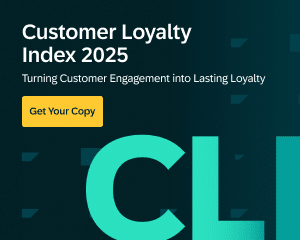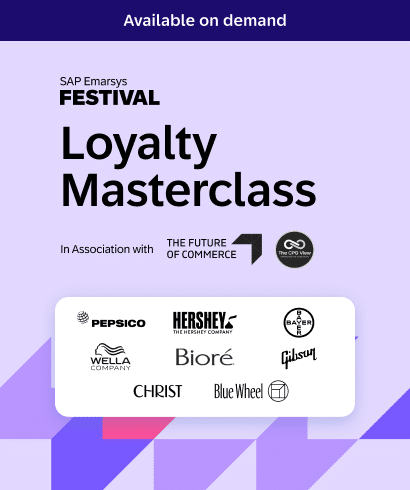Delivering a seamless customer experience isn’t optional anymore. It’s what your customers expect. Whether they’re browsing on their phone, opening an email, shopping in-store, or scrolling social media, they want a consistent, personalized interaction that feels like it was made just for them. That’s the power of omnichannel personalization.
But while the concept is simple, execution is where most brands stumble. It takes the right mix of data, technology, and strategy to unify customer touchpoints and deliver relevant, 1:1 engagement at scale. The good news? Many brands are already doing it, and seeing incredible results.
In this article, we’ve rounded up 17 real-world examples from leading brands using SAP Emarsys to master omnichannel personalization. Each one shows how unifying customer data and tailoring experiences across every channel can drive loyalty, retention, and revenue, and we’ll show you exactly how you can apply their strategies.
1. City Beach: Scaling 1:1 Engagement Across Channels
City Beach wanted more than just campaign automation. They aimed to deliver genuine 1:1 engagement across every customer touchpoint. By unifying their data into a single customer view, the retailer could integrate loyalty programs, automate personalized campaigns, and deliver consistent messaging across email, web, social, and in-store.
With AI-powered recommendations and predictive segmentation, City Beach created a seamless experience for customers, whether they were redeeming points in-store or clicking on a targeted ad online. The result? Higher retention, more revenue, and a better overall customer experience.
Key takeaway: Unifying data across all channels is the foundation for scalable, effective personalization.

2. PatPat: Doubling Revenue With Omnichannel Personalization
PatPat’s challenge was clear: they needed to turn fragmented customer data into a connected, actionable asset. By combining automation with omnichannel personalization, PatPat could deliver targeted offers and recommendations to the right customer, at the right time, on the right channel.
Using SAP Emarsys, the children’s clothing brand streamlined communications across email, push notifications, and web, ensuring every interaction felt relevant and timely. This approach not only boosted engagement but also doubled their revenue in a short space of time.
Key takeaway: Pairing automation with omnichannel personalization maximizes both customer satisfaction and bottom-line growth.
3. Versuni: Creating a Cohesive Experience Across Every Platform
Versuni (formerly Philips Domestic Appliances) serves customers in more than 100 countries, which means every touchpoint needs to feel both local and connected. Before SAP Emarsys, campaigns were siloed by channel, making it difficult to deliver a unified experience.
By integrating Emarsys with their ecommerce platform, CRM, and service tools, Versuni built a single customer view containing purchase history, browsing behavior, and engagement data. They use this to trigger automated journeys such as replenishment reminders, personalized onboarding, and seasonal product recommendations — all timed to when customers are most likely to buy.
This shift not only increased repeat purchase rates but also reduced campaign creation time, allowing local teams to quickly adapt global templates for their market.
Key takeaway: Combining global strategy with localized, automated personalization ensures consistency without sacrificing relevance.
4. Pour Moi: Building Loyalty With a Single Customer View
UK-based fashion retailer Pour Moi wanted to deepen relationships with both retail and online customers but struggled to connect data from different channels. This meant email, social, and on-site experiences weren’t telling the same story.
With SAP Emarsys, Pour Moi integrated ecommerce, POS, and marketing data into a central profile for each customer. This enabled advanced segmentation — for example, targeting swimwear buyers with matching cover-ups, or sending personalised birthday offers tied to past purchases.
They also used predictive models to identify customers at risk of lapsing and re-engage them with tailored discounts or exclusive previews. Within the first month, the approach grew their active customer database by 16% and significantly improved email conversion rates.
Key takeaway: Linking online and offline data opens the door to more timely, relevant, and loyalty-driving campaigns.

5. Home Depot Mexico: Driving Growth With Omnichannel Personalization
In Mexico’s competitive home improvement market, Home Depot set out to create a shopping journey that felt effortless whether customers were online, in the app, or in-store. The challenge: customer data was scattered across channels.
By centralizing data in SAP Emarsys, they gained the ability to deliver personalized recommendations based on project type, purchase history, and browsing behavior. For example, a customer buying paint online could receive automated follow-ups suggesting brushes, tape, and drop cloths, both via email and in-app.
They also integrated SMS into their onboarding flow, achieving a higher open rate for first-purchase offers and keeping customers engaged from the very first interaction. This coordinated, omnichannel approach has been credited with driving repeat purchases and increasing average order value in a highly price-sensitive market.
Key takeaway: Using personalization to anticipate customer needs across channels turns convenience into loyalty.
6. ALDO Group: Creating an Omnichannel Experience From the Ground Up
Global footwear and accessories retailer ALDO knew its customers didn’t think in terms of “channels”. They expected a seamless experience whether browsing a store window, scrolling Instagram, or shopping on the website.
By integrating SAP Emarsys with its ecommerce and CRM systems, ALDO built unified customer profiles combining in-store purchases, online orders, and engagement history. This allowed them to deliver personalised content across every touchpoint:
- Customising homepage banners with products relevant to each shopper.
- Retargeting customers on social media with items they’d browsed but not purchased.
- Sending automated replenishment emails for essentials like shoe care products.
With omnichannel orchestration, ALDO reduced campaign lead times, improved click-through rates, and strengthened loyalty program engagement.
Key takeaway: A truly unified commerce approach goes beyond syncing data, turning that data into meaningful, coordinated experiences.
7. PUMA: Scaling Omnichannel Personalization to a Global Audience
With customers in over 120 countries, PUMA needed to personalise communications across multiple languages, currencies, and culture, all without losing speed to market.
Using SAP Emarsys’ Personalization Engine, PUMA connected ecommerce, loyalty, and behavioural data to trigger highly targeted campaigns. Examples include:
- Personalised product recommendations based on browsing and purchase history.
- Dynamic vouchers tied to loyalty tiers.
- Location-specific offers timed around local sporting events or product launches.
Automating these campaigns meant local marketing teams could focus on creative strategy while maintaining consistency across global regions. Within six months, PUMA saw a 5× revenue uplift from automated campaigns and 50% database growth.
Key takeaway: Personalisation at scale is possible, but only if you centralise data and automate execution.
8. FC Bayern: Engaging Fans With 250 Data Points
FC Bayern is a global brand with millions of fans, each with unique preferences and behaviours. To engage such a diverse audience, the club turned to SAP Emarsys to connect ticketing, merchandise, app, and email data into one profile per fan.
With over 250 fan attributes in play, from favourite players to match attendance history, FC Bayern delivers campaigns that feel genuinely personal. A fan who attends away matches, for example, might receive travel package offers, while a merchandise buyer could get early access to new kit launches.
These insights power omnichannel engagement across email, push notifications, social ads, and the club’s own app, deepening loyalty and driving revenue on and off the pitch.
Key takeaway: The more relevant data you have, the more precisely you can tailor experiences and the more loyal your customers (or fans) will be.

9. Levi’s: Stitching Together a True Omnichannel Strategy
For Levi’s, customer relationships span decades, but modern loyalty requires more than heritage. The brand wanted to connect online and in-store data to deliver a consistent, personalised experience no matter how customers shopped.
With SAP Emarsys, Levi’s created unified customer profiles drawing from ecommerce, point-of-sale, and digital ad platforms. This allowed them to:
- Automate replenishment and back-in-stock alerts for popular styles.
- Personalise email content with items similar to a customer’s past purchases.
- Retarget across paid social and search to re-engage high-intent shoppers.
Omnichannel automation now drives 30% of Levi’s online revenue, and the next step is integrating physical store data to make in-store experiences just as personalised as online.
Key takeaway: Connecting in-store and online data closes the loop on the omnichannel journey and unlocks major revenue potential.
10. Krispy Kreme: Bridging the Gap Between Retail and Digital
Krispy Kreme operates a strong retail presence alongside ecommerce and delivery partnerships but siloed systems made it hard to see the full customer journey.
By unifying their data in SAP Emarsys, they could see how customers interacted across channels and personalise accordingly. For example:
- App users who ordered seasonal doughnuts could receive early alerts for the next flavour drop.
- In-store buyers could get digital coupons encouraging them to try online ordering.
This omnichannel approach ensured that loyalty rewards, messaging, and offers were consistent everywhere a customer engaged with the brand. It also allowed Krispy Kreme to run targeted, time-sensitive promotions without sacrificing personalisation.
Key takeaway: Breaking down silos between in-store and digital channels opens the door to more consistent, impactful customer engagement.
11. Total Tools: Turning Data Into Loyalty Across Channels
Total Tools knew their customers, tradies and DIYers, valued convenience and relevance. But without a connected data system, their marketing couldn’t deliver on either.
By implementing SAP Emarsys, they built a unified view of each customer’s purchase history, tool preferences, and loyalty status. This data fuels campaigns like:
- Sending trade-specific product bundles to customers based on past purchases.
- Offering bonus loyalty points during seasonal promotions across email, SMS, and in-app.
- Triggering replenishment reminders for consumables like drill bits or safety gear.
This omnichannel personalisation boosted customer satisfaction and drove repeat sales, while their loyalty program became a key retention tool.
Key takeaway: Personalised recommendations tied to loyalty rewards give customers both a reason and a reward to keep coming back.
12. Pizza Hut: Boosting Conversions With an Omnichannel Onboarding Flow
Pizza Hut wanted to make sure new customers loved the experience so much that they became repeat buyers. The challenge was creating a welcome experience that worked across multiple touchpoints and stayed relevant from day one.
Using SAP Emarsys, they built an omnichannel onboarding journey that combined email, SMS, and app notifications. One standout result: a 15% SMS conversion rate for first-time purchase offers. They also used customer data to segment by order preferences, so a customer who ordered vegetarian pizza would receive personalised menu suggestions that matched their taste.
By keeping messaging consistent across channels, Pizza Hut reinforced brand familiarity while increasing the likelihood of a second purchase.
Key takeaway: A well-timed, multi-channel welcome series can turn first-time buyers into long-term loyal customers.

13. Ferrara: Building Hyper-Personalised Experiences From a Single Data Source
Ferrara, the US confectionery giant behind brands like Nerds and Trolli, needed to connect its various customer touchpoints into one cohesive view. With SAP Emarsys, they combined CRM, ecommerce, and loyalty data into a centralised profile for each customer.
This allowed Ferrara to deliver omnichannel personalisation such as:
- Loyalty-based product recommendations in email and on-site.
- Targeted seasonal promotions based on past purchase behaviour.
- Personalised reactivation campaigns for lapsed customers, tailored to their favourite products.
By unifying their data, Ferrara moved from mass campaigns to precision marketing that feels relevant on every channel, improving both engagement and conversion.
Key takeaway: A centralised data foundation makes it possible to deliver personalised experiences that scale across every channel.
14. Betclic: Integrating Data for a Frictionless Omnichannel Experience
Online gaming company Betclic wanted to reduce friction and create a more consistent customer journey across web, app, and email. Before SAP Emarsys, siloed systems meant personalisation was limited and campaign coordination was difficult.
After integrating data sources into Emarsys, Betclic gained full omnichannel visibility into each player’s behaviour. They used this to automate personalised experiences such as:
- Sending targeted offers based on preferred sports or games.
- Timing promotions around key sporting events for maximum relevance.
- Retargeting inactive players with relevant incentives across email and push notifications.
The result was smoother campaign delivery, higher engagement, and a better overall player experience.
Key takeaway: Omnichannel personalisation isn’t just for retail. Service and entertainment brands can use it to increase relevance and retention too.
15. Contorion: Delivering Omnichannel Loyalty at Every Touchpoint
B2B tool retailer Contorion wanted to make its loyalty program visible and usable wherever customers engaged, from email to website to account portal. Before SAP Emarsys, loyalty data was isolated, making it hard to integrate with marketing campaigns.
By unifying loyalty and purchase data into a single customer profile, Contorion could display loyalty points, status, and personalised offers across all channels. For example, a customer browsing the website might see a tailored product recommendation alongside their current points balance, with an incentive to redeem for a discount.
This omnichannel loyalty approach kept the program top-of-mind, increased engagement, and gave customers a reason to interact beyond transactions.
Key takeaway: Integrating loyalty data into every channel makes rewards more relevant and more likely to be used.

16. Gibson: Hitting the Right Notes With Omnichannel Journeys
Iconic guitar maker Gibson wanted to connect with musicians at every stage of their journey, from buying their first instrument to upgrading years later. With SAP Emarsys, they created omnichannel customer journeys that drew on purchase history, engagement data, and product registration information.
This meant a new guitar buyer might get onboarding emails with care tips, an invite to join Gibson’s loyalty program, and social retargeting with accessories or lessons. Long-term customers could receive personalised anniversary offers or early access to limited edition models.
By orchestrating these experiences across email, social, web, and in-store events, Gibson turned one-time buyers into lifelong fans.
Key takeaway: Omnichannel personalisation can transform a transaction into a long-term brand relationship.
17. Wella Company: Personalising Product Launches at Scale
Wella Company operates in over 100 markets and frequently launches new products, but scaling personalised campaigns across so many countries was a challenge.
Using SAP Emarsys, Wella combined ecommerce and CRM data with market-specific insights to create personalised, omnichannel launch campaigns. Customers who’d purchased similar products in the past received targeted recommendations and offers via email, while social ads and in-store promotions reinforced the same message.
This mix of global automation and local customisation allowed Wella to launch at speed while keeping communications relevant to each market, boosting both launch-day sales and long-term adoption.
Key takeaway: Automating core campaign elements frees up local teams to add the personal touches that drive results.







